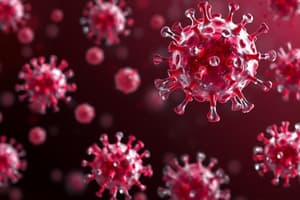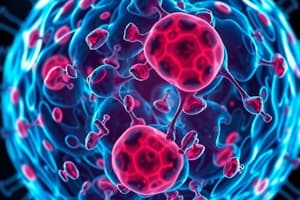Podcast
Questions and Answers
Where do B cells get activated?
Where do B cells get activated?
In the periphery, where they have antibodies on their surface to bind to antigens.
How do B cells get activated?
How do B cells get activated?
1st signal by the antigen, 2nd signal by the T cell, 3rd signal by cytokines from the T cell.
What type of interaction with T cells is required for T cell dependent B cell activation?
What type of interaction with T cells is required for T cell dependent B cell activation?
Cognate interaction.
What interaction is necessary with the T cell co-stimulatory molecule?
What interaction is necessary with the T cell co-stimulatory molecule?
What are on B cell surfaces that help it become activated?
What are on B cell surfaces that help it become activated?
How does the MHC molecule display an antigen to the T cell?
How does the MHC molecule display an antigen to the T cell?
T cells can ONLY see an antigen from a B cell if?
T cells can ONLY see an antigen from a B cell if?
Explain the role of T cells in B cell activation in T dependent B-cell activation.
Explain the role of T cells in B cell activation in T dependent B-cell activation.
What activates T cells and can be found on the surface of B cells when it has been bound with an antigen?
What activates T cells and can be found on the surface of B cells when it has been bound with an antigen?
What is the first step in B cell activation?
What is the first step in B cell activation?
What delivers the signals of the antigen crosslinking with antibodies/BCRs?
What delivers the signals of the antigen crosslinking with antibodies/BCRs?
What are the 3 major intracellular signaling pathways ending in transcription factors that get triggered upon B cell activation?
What are the 3 major intracellular signaling pathways ending in transcription factors that get triggered upon B cell activation?
Describe the NF-AT ending intracellular signaling pathways triggered upon B cell activation.
Describe the NF-AT ending intracellular signaling pathways triggered upon B cell activation.
Describe the NF-KB ending intracellular signaling pathways triggered upon B cell activation.
Describe the NF-KB ending intracellular signaling pathways triggered upon B cell activation.
Describe the AP-1 ending intracellular signaling pathways triggered upon B cell activation.
Describe the AP-1 ending intracellular signaling pathways triggered upon B cell activation.
What is in the B cell coreceptor?
What is in the B cell coreceptor?
How do B cell coreceptors amplify activation?
How do B cell coreceptors amplify activation?
Activation of resting B cells by T helper cells depends directly upon costimulatory interaction between?
Activation of resting B cells by T helper cells depends directly upon costimulatory interaction between?
What is negative signaling?
What is negative signaling?
Which B cell types actually secrete antibodies?
Which B cell types actually secrete antibodies?
CD19 is usually a marker found on ALL types of B cells.
CD19 is usually a marker found on ALL types of B cells.
What is special about CD81, an aspect of the B cell coreceptor?
What is special about CD81, an aspect of the B cell coreceptor?
Describe T (independent antigen) T1 vs T2.
Describe T (independent antigen) T1 vs T2.
Flashcards
B Cell Activation
B Cell Activation
B cells get activated in peripheral tissues by binding antigens via surface antibodies.
B Cell Activation Signals
B Cell Activation Signals
Antigen binding to BCRs, plus T cell signals (and sometimes cytokines).
Cognate Interaction
Cognate Interaction
Direct physical interaction between B and T cells for B cell activation.
B Cell Costimulation
B Cell Costimulation
Signup and view all the flashcards
B Cell Surface Markers for Activation
B Cell Surface Markers for Activation
Signup and view all the flashcards
MHC Function in B Cells
MHC Function in B Cells
Signup and view all the flashcards
T Cell Antigen Recognition
T Cell Antigen Recognition
Signup and view all the flashcards
Role of T Cells in B Cell Activation
Role of T Cells in B Cell Activation
Signup and view all the flashcards
MHC Expression Post-Antigen Binding
MHC Expression Post-Antigen Binding
Signup and view all the flashcards
Initial B Cell Activation Step
Initial B Cell Activation Step
Signup and view all the flashcards
BCR Signal Transduction
BCR Signal Transduction
Signup and view all the flashcards
Major Intracellular Signaling Pathways
Major Intracellular Signaling Pathways
Signup and view all the flashcards
NF-AT Pathway Summary
NF-AT Pathway Summary
Signup and view all the flashcards
NF-KB Pathway Summary
NF-KB Pathway Summary
Signup and view all the flashcards
AP-1 Pathway Summary
AP-1 Pathway Summary
Signup and view all the flashcards
B Cell Coreceptor Components
B Cell Coreceptor Components
Signup and view all the flashcards
Coreceptor Amplification
Coreceptor Amplification
Signup and view all the flashcards
T Helper Cell Interaction
T Helper Cell Interaction
Signup and view all the flashcards
Negative Signaling
Negative Signaling
Signup and view all the flashcards
Antibody-Secreting B Cell Type
Antibody-Secreting B Cell Type
Signup and view all the flashcards
CD19 Marker Specificity
CD19 Marker Specificity
Signup and view all the flashcards
Unique Feature of CD81
Unique Feature of CD81
Signup and view all the flashcards
T-Independent Antigens
T-Independent Antigens
Signup and view all the flashcards
Study Notes
B Cell Activation Overview
- B cells become activated in the periphery, utilizing surface antibodies to bind to specific antigens.
Activation Signals
- Initial activation requires two signals:
- First signal from the antigen binding to B cell receptors.
- Second signal from T cells, with potential cytokine assistance as a third signal.
Cognate Interaction
- A cognate interaction between B cells and T cells is essential for T cell-dependent B cell activation.
Costimulatory Molecules
- Activation interaction involves CD40L on T cells interacting with CD40 receptors on B cells.
Surface Markers and Activation
- Key components on B cell surfaces aiding activation include:
- Antibodies for antigen binding.
- MHC molecules that present antigen peptides to T cells.
- CD40 receptors which receive signals from T cell CD40L.
- Complement receptors facilitating the immune response.
MHC Function
- B cells endocytose antigens, process them, and present peptide fragments on MHC molecules for T cell recognition.
T Cell Interaction Requirement
- T cells can only recognize antigens presented by B cells through their MHC molecules.
Role of T Cells
- T cells activate B cells via MHC recognition, provide necessary signals for B cell activation, and secrete cytokines to further stimulate B cell function.
MHC Activation Post-Antigen Binding
- MHC molecules on B cells express antigenic peptides only after binding with an antigen.
Initial B Cell Activation Step
- The first step involves cross-linking of B cell receptors (BCRs) by antigens, leading to B cell activation.
Signal Transduction
- Signals from antigen cross-linking are conveyed through an Ig-alpha and Ig-beta heterodimer, activating a cascade resulting in B cell proliferation and differentiation.
Intracellular Signaling Pathways
- Major intracellular signaling pathways initiated in B cell activation include:
- NF-AT pathway.
- NF-KB pathway.
- AP-1 pathway.
NF-AT Pathway
- Involves PIP2 conversion to IP3 leading to Ca2+ and calmodulin activation, with subsequent dephosphorylation of NF-AT and its migration to the nucleus for cytokine production.
NF-KB Pathway
- Involves PIP2 to DAG and activation of PKC which phosphorylates IKB, releasing active NF-KB to enter the nucleus and promote cytokine production.
AP-1 Pathway
- Activated by Ras and Rac G proteins, leading to AP-1 transcription factor activation which enters the nucleus to stimulate cytokine expression.
B Cell Coreceptor Components
- Coreceptor includes:
- CD19
- CD21 (CR2)
- CD81 (TAPA-1)
Coreceptor Amplification
- Coreceptor binds to bacteria/antigens and delivers a strong activation signal when complement fragments interact with CR2/CD21.
T Helper Cell Interaction
- Activation of resting B cells by T helper cells relies on CD40-CD40L costimulatory interaction.
Negative Signaling Mechanism
- B cell activation needs to be regulated; Fc receptors (CD32) can inhibit signaling by phosphorylating ITIMs to downregulate Ig synthesis and B cell effectiveness.
Antibody-Secreting B Cell Type
- Plasma cells, or effector B cells, are responsible for antibody secretion.
CD19 Marker Specificity
- CD19 is generally present on all B cells except for plasma cells.
Unique Feature of CD81
- CD81 spans the transmembrane domain four times, denoting its distinctive structure among B cell coreceptor components.
T-Independent Antigens
- TI-1 antigens activate B cells via BCRs and Toll-like receptors, highlighting the complexity of B cell activation stimuli.
Studying That Suits You
Use AI to generate personalized quizzes and flashcards to suit your learning preferences.




